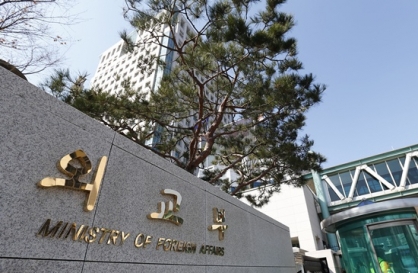South Korea's economic growth rate is feared to stagnate or lapse into negative territory in the first half of 2012 on escalating global economic uncertainties that could make a significant dent in the export-focused economy, analysts warned Sunday.
The warning came a day after global credit ratings agency Standard & Poor's downgraded the credit ratings of nine European countries amid the region's debt crisis, including France, whose credit rating was knocked down by one notch from AAA to AA+.
The analysts said the simmering eurozone sovereign debt turmoil will inevitably have a direct impact on the region's economies and subsequently dampen South Korean exports to them. Shipments to the European Union (EU) accounted for 10 percent of South Korea's overall exports last year.
To make matters worse, financial instability in Europe is expected to increase burdens on the United States and China, the world's top two economies, and put a damper on the export-oriented South Korean economy, they added.
"We can not rule out the possibility that South Korea's first-quarter growth will rate remain flat from the previous quarter or shrink," said Bae Sang-keun, a senior researcher at the Federation of Korean Industries, or the lobby for South Korea's top conglomerates.
Private consumption, corporate capital spending and construction investment are unlikely to pick up the slack, creating a highly unfavorable environment and prolonging the economic slump into the second quarter of this year, he said.
In a recent outlook on the South Korean economy, global investment bank Nomura said Asia's fourth-largest economy will likely contract 0.1 percent in the current quarter from the fourth quarter of last year.
Nomura also cut its full-year growth for the South Korean economy to 3 percent from 5 percent made last year, saying South Korea will be hit hardest by the fallout from Europe's fiscal crisis and slumping demand from China.
Credit Suisse, JP Morgan and several global investment banks have forecast the eurozone to post negative growth rate in the first quarter of this year, following a contraction during the fourth quarter of last year.
The prediction has sparked worries over a severe negative impact on South Korean exports to the economic bloc.
In a recent report, Daishin Economic Research Institute predicted that a 1 percent drop in the EU growth rate would shave 4 percent off South Korea's shipments to the region.
South Korean exports to the EU rose 5.5 percent on-year to $54.3 billion in 2011. The annual growth rate was far lower than the previous year's 14.8 percent surge.
A fall in South Korea's exports is feared to worsen its domestic problems, such as high household debts, watchers said.
"Falling exports could slow economic growth, reducing household income and weakening households' ability to repay debts," an analyst said on condition of anonymity. "That could in turn cool the economy further and atrophy private consumption, creating a serious crisis." (Yonhap News)
<한글기사>
韓경제 `내우외환' 증폭…2∼4월 위기설 확산
한국경제가 갈수록 `내우외환'에 시달리고 있다.
유럽 국가들은 무더기 신용등급 강등 사태로 더욱 위기상황으로 치닫고 있으며 핵개발을 둘러싼 미국과 이란의 갈등은 국제유가 급등을 초래할 가능성이 있다. 한 국이 크게 의존하는 중국경제도 경착륙 가능성을 배제할 수 없으며 인도와 브라질 경제도 흔들리고 있다.
한국의 정치와 사회는 총선과 대선을 앞두고 극도의 혼란과 갈등상태로 빠져들 고 있으며 잠복한 `북한 리스크'는 언제 수면위로 올라올지 모르는 상황이다.
이런 국내외 불안상황을 반영해 한국경제의 1분기 성장률은 0% 또는 마이너스에 머물 것이라는 전망이 나오고 있다. 각종 위험지표도 이미 상승하고 있는 추세다.
15일 국제금융센터와 금융투자업계에 따르면 유럽국가들에 대한 무더기 신용등 급 강등 여파 등으로 2∼4월에 위기가 발생할 것이라는 우려가 커지고 있다. 예고된 악재지만 2월부터 본격화되는 이탈리아와 스페인 등 유럽국가들의 국채만기 상환부 담이 더 늘어나기 때문이다. 스페인의 국가신용등급은 이번에 2단계나 강등돼 'PIGS '국가중 그리스에 이어 두 번째로 투기등급으로 추락했다.
이탈리아는 2월 531억유로를 시작으로 3월 442억유로, 4월에는 441억유로의 국 채 만기를 맞는다. 올해가 만기인 전체 3천309억유로 가운데 40% 이상이 이 기간에 집중적으로 돌아온다. 스페인의 2~4월 만기 도래액은 504억유로로 올해 만기액의 36 %를 차지한다
유로존 국가들의 신용등급 강등으로 유럽재정안정기금(EFSF) 마저 `AAA' 등급 유지가 어려워지는 상황이다.
채권 손실률을 놓고 정부와 채권단 간의 협상에 난항을 겪는 그리스도 3월말에 대규모 국채 만기를 맞는다. 그리스는 이 위기를 넘기지 못하면 디폴트에 직면할 것 이라는 전망이 나오고 있다.
유럽 외의 지역에서도 위험요인이 적지 않다.
중국은 지급준비율 인하 등의 부양책에 나서고 있으나 주택시장을 중심으로 한 경기 하강 위험은 해소되지 않고 있다. 인도와 브라질의 경제도 흔들리고 있다.
이란의 핵개발을 둘러싼 미국과의 갈등은 국제유가 급등 우려를 낳고 있다. 국 제유가 상승은 물가불안뿐 아니라 기업체의 채산성을 악화시킨다.
현대경제연구원은 최근 보고서에서 이란과 미국의 갈등으로 호르무즈 해협 봉쇄 가 장기화하면 유가가 배럴당 210달러까지 오를 것으로 예상했다. 이 경우 올해 한 국 경제성장률은 2.8%로 떨어지고 물가상승률은 7.1%로 오를 것으로 전망됐다.
한국 내부의 정치ㆍ사회 상황도 여의치 않다.
여권과 야권은 전당대회 돈 봉투 사건 등으로 극도의 `혼돈' 상태에 빠졌고 소 값 파동이나 학교폭력 등에서 드러났듯이 사회적 갈등과 혼란도 심각한 수준이다.
이런 복합적 불안요인 등으로 한국의 1분기 경제성장률(전분기 대비)이 마이너 스를 기록할 가능성이 있으며 올해 연 3%대의 성장을 장담할 수 없다는 비관적 전망 까지 나오고 있다.
배상근 전국경제인연합회 경제본부장은 "올해 1분기 한국경제 성장률은 전분기 대비 0% 또는 마이너스일 가능성을 배제할 수 없다"고 말했다.
한국경제의 위험지표도 다시 상승하는 추세다.
한국의 2014년 4월 외국환평형기금 가산금리와 신용부도스와프(CDS) 금리가 지 난 13일 기준 175bp(1bp=0.01%)까지 상승했다. 올해 171bp로 출발한 외평채 가산금 리는 지난 9일 168bp까지 하락했다가 상승 반전하고 있다.
올해 들어 한국의 CDS프리미엄은 지난 3일 154bp에서 9일 171bp로 치솟는 등 불 안한 흐름을 보이다가 소폭 반락했다. 한국의 신용부도스와프(CDS) 프리미엄은 13일 뉴욕 장외시장에서 전날보다 2bp 하락한 165bp로 마감했다.
지난해 8~9월 금융위기 여파로 작년 10월 4일 229bp까지 치솟았던 한국의 CDS 프리미엄은 10월 28일 127bp까지 내려갔다가 다시 하락폭의 절반 이상 뛰어올랐다.




![[Weekender] Korean psyche untangled: Musok](http://res.heraldm.com/phpwas/restmb_idxmake.php?idx=644&simg=/content/image/2024/05/02/20240502050841_0.jpg&u=)

![[Eye Interview] 'If you live to 100, you might as well be happy,' says 88-year-old bestselling essayist](http://res.heraldm.com/phpwas/restmb_idxmake.php?idx=644&simg=/content/image/2024/05/03/20240503050674_0.jpg&u=)










![[Herald Interview] Director of 'Goodbye Earth' aimed to ask how we would face apocalypse](http://res.heraldm.com/phpwas/restmb_idxmake.php?idx=652&simg=/content/image/2024/05/03/20240503050732_0.jpg&u=)
